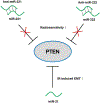Long and short non-coding RNA and radiation response: a review
- PMID: 33582242
- PMCID: PMC8475769
- DOI: 10.1016/j.trsl.2021.02.005
Long and short non-coding RNA and radiation response: a review
Abstract
Once thought of as arising from "junk DNA," noncoding RNAs (ncRNAs) have emerged as key molecules in cellular processes and response to stress. From diseases such as cancer, coronary artery disease, and diabetes to the effects of ionizing radiation (IR), ncRNAs play important roles in disease progression and as biomarkers of damage. Noncoding RNAs regulate cellular processes by competitively binding DNA, mRNA, proteins, and other ncRNAs. Through these interactions, specific ncRNAs can modulate the radiosensitivity of cells and serve as diagnostic and prognostic biomarkers of radiation damage, whether from incidental exposure in radiotherapy or in accidental exposure scenarios. Analysis of RNA expression after radiation exposure has shown alterations not only in mRNAs, but also in ncRNAs (primarily miRNA, circRNA, and lncRNA), implying an important role in cellular stress response. Due to their abundance and stability in serum and other biofluids, ncRNAs also have great potential as minimally invasive biomarkers with advantages over current biodosimetry methods. Several studies have examined changes in ncRNA expression profiles in response to IR and other forms of oxidative stress. Furthermore, some studies have reported modulation of radiosensitivity by altering expression levels of these ncRNAs. This review discusses the roles of ncRNAs in the radiation response and evaluates prior research on ncRNAs as biomarkers of radiation damage. Future directions and applications of ncRNAs in radiation research are introduced, including the potential for a clinical ncRNA assay for assessing radiation damage and for the therapeutic use of RNA interference (RNAi).
Published by Elsevier Inc.
Figures





Similar articles
-
Noncoding RNA crosstalk in brain health and diseases.Neurochem Int. 2021 Oct;149:105139. doi: 10.1016/j.neuint.2021.105139. Epub 2021 Jul 16. Neurochem Int. 2021. PMID: 34280469 Free PMC article. Review.
-
Emerging role of non-coding RNAs in response of cancer cells to radiotherapy.Pathol Res Pract. 2021 Feb;218:153327. doi: 10.1016/j.prp.2020.153327. Epub 2020 Dec 28. Pathol Res Pract. 2021. PMID: 33422780 Review.
-
Non-Coding RNAs in Neurological and Neuropsychiatric Disorders: Unraveling the Hidden Players in Disease Pathogenesis.Cells. 2024 Jun 19;13(12):1063. doi: 10.3390/cells13121063. Cells. 2024. PMID: 38920691 Free PMC article. Review.
-
Non-Coding RNAs in Legumes: Their Emerging Roles in Regulating Biotic/Abiotic Stress Responses and Plant Growth and Development.Cells. 2021 Jul 2;10(7):1674. doi: 10.3390/cells10071674. Cells. 2021. PMID: 34359842 Free PMC article. Review.
-
Emerging Roles of miRNA, lncRNA, circRNA, and Their Cross-Talk in Pituitary Adenoma.Cells. 2022 Sep 19;11(18):2920. doi: 10.3390/cells11182920. Cells. 2022. PMID: 36139495 Free PMC article. Review.
Cited by
-
DAMPs and radiation injury.Front Immunol. 2024 Jan 25;15:1353990. doi: 10.3389/fimmu.2024.1353990. eCollection 2024. Front Immunol. 2024. PMID: 38333215 Free PMC article. Review.
-
Cardiovascular complications of diabetes: role of non-coding RNAs in the crosstalk between immune and cardiovascular systems.Cardiovasc Diabetol. 2023 May 24;22(1):122. doi: 10.1186/s12933-023-01842-3. Cardiovasc Diabetol. 2023. PMID: 37226245 Free PMC article. Review.
-
A Review of Radiation-Induced Alterations of Multi-Omic Profiles, Radiation Injury Biomarkers, and Countermeasures.Radiat Res. 2023 Jan 1;199(1):89-111. doi: 10.1667/RADE-21-00187.1. Radiat Res. 2023. PMID: 36368026 Free PMC article. Review.
-
Investigations into the impact of non-coding RNA on the sensitivity of gastric cancer to radiotherapy.Front Physiol. 2023 Feb 24;14:1149821. doi: 10.3389/fphys.2023.1149821. eCollection 2023. Front Physiol. 2023. PMID: 36909247 Free PMC article. Review.
-
The function of chaperones in the radioresistance of glioblastoma: a new insight into the current knowledge.Brain Tumor Pathol. 2025 Jul;42(3):51-67. doi: 10.1007/s10014-025-00501-7. Epub 2025 Apr 21. Brain Tumor Pathol. 2025. PMID: 40259161 Review.
References
-
- Fenech M Current status, new frontiers and challenges in radiation biodosimetry using cytogenetic, transcriptomic and proteomic technologies. Radiation Measurements 46, 737–741 (2011).
-
- Pennisi E ENCODE project writes eulogy for junk DNA. Science 337, 1159, 1161 (2012). - PubMed
Publication types
MeSH terms
Substances
Grants and funding
LinkOut - more resources
Full Text Sources
Other Literature Sources

